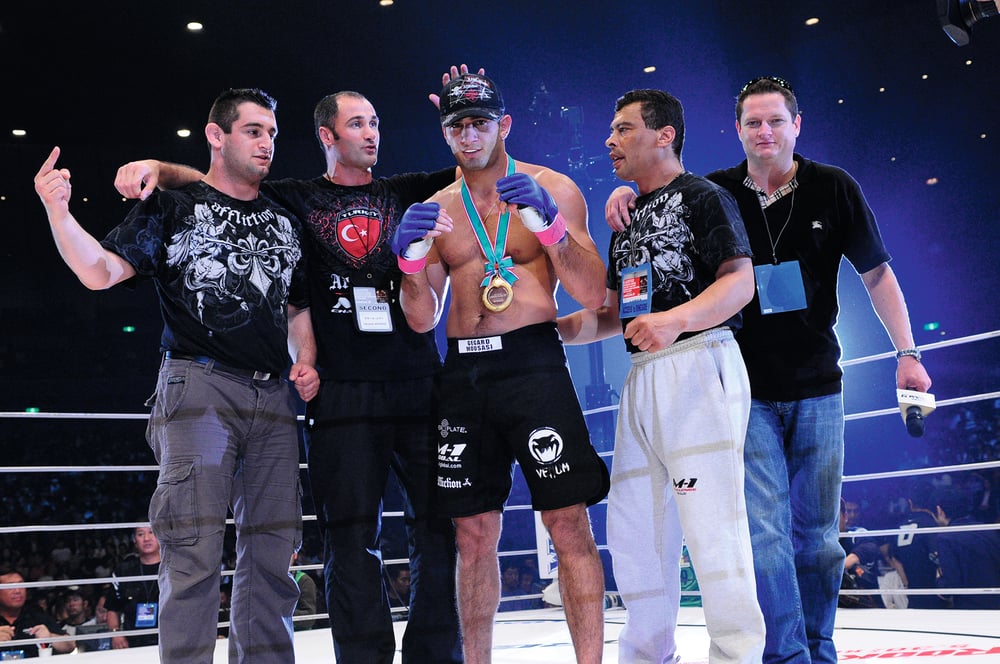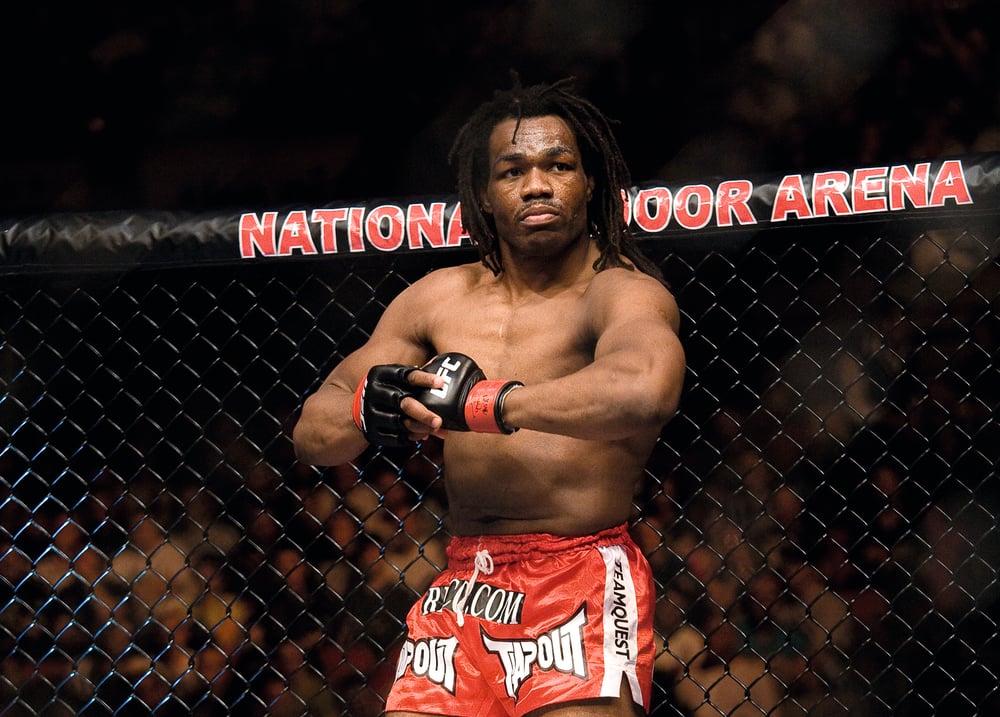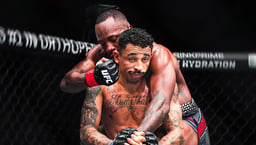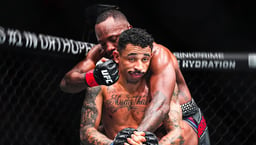
Issue 055
October 2009
Our resident experts preview three upcoming fights in their own very different ways.
First, Andrew Garvey takes a look at the bigger picture. What are the career implications for the combatants? Where are they coming from, and what will victory or defeat hold for them? Next, Fighters Only’s technique expert, Peter Irving, breaks down the strategic and tactical considerations.
Breakdown by the Numbers
Lyoto Machida vs Mauricio ‘Shogun’ Rua
20%
of Machida’s 15 fights that have ended in the first round (3)
7
Total number of strikes Rashad Evans managed to land on the elusive Machida during their fight at UFC 99.
14
Number of fights Shogun has finished in the first round.
16
Number of MMA fights in which Machida is unbeaten.
2
Inch reach advantage Shogun (76”) has over Machida (74”). They are both 6’1” in height.
84%
of fights Shogun has ended by KO or TKO
Lyoto Machida vs Mauricio ‘Shogun’ Rua
UFC 104, Los Angeles, California,
October 24, 2009
The Bigger Picture
Forget all that nonsense you’ve heard about developing every aspect of the sport and being a well-rounded fighter: All you really need is karate!
Lyoto Machida has single-handedly rescued karate from the bargain basement of mumbo-jumbo riddled and inapplicable traditional martial arts, and made it relevant like it’s the 1970s all over again. Obviously the truth is a little more subtle than that. Machida has taken his father’s brand of karate, blended it with a diverse range of techniques and styles and (most importantly) used his own natural gifts to craft an unmistakable and frighteningly effective fighting style that only he can truly pull off.
Coming off four of the best performances of his career, the 31-year-old Japanese-Brazilian should be a heavy favorite in this, the very first defense of his UFC light heavyweight title. Things have certainly changed for Machida over the last couple of years. His first few UFC fights were deeply frustrating to watch. Completely outclassing his opponents, he simply failed to show much aggression or any inclination to actually finish a fight inside the distance.
That changed in December 2007 when he faced UFC newcomer Sokoudjou. Machida floored him and slickly choked him out in the second round. Five months later, Machida survived a last-ditch triangle choke to decision Tito Ortiz when he utterly dominated the former UFC poster boy in a dramatic, impressive fight. Machida followed up with his chilling KO of fellow unbeaten striker (albeit of the ‘wildman’ variety) Thiago Silva at UFC 94. That earned him a shot at titleholder Rashad Evans – the one man in his division who could possibly match him for speed, power and elusiveness. Sadly for Rashad, he actually couldn’t. Machida just destroyed him in that patient, tactical, and all-of-a-sudden popular and utterly enthralling way, finishing with a fantastic second-round knockout.
Given Machida’s exceptional style, physical gifts and ability to make his opponents look like lumbering oafs, it may be difficult to find people actually willing to fight him. Luckily ‘Shogun’ Rua was willing to take a hefty swig from the poisoned chalice of a title shot in the new Machida era.
Bedeviled by injuries, inconsistency and a change in setting, rules and whatever else has made plenty of former Pride FC superstars look so ordinary in the Octagon, Shogun is 2-1-0 in his UFC career. His debut was nightmarish and painful. The betting favorite, he gassed out and suffered a righteous beating at the hands of Forrest Griffin before eventually submitting to a choke late in the third. In some ways, Shogun looked even worse in his
slow-motion slugfest with the comparatively ancient Mark Coleman at UFC 93 (a fight Rua was expected to win handily). He looked awful, gassed out again and finally finished the gutsy elder statesman of the sport very late in the third.
At UFC 97, Rua finally lived up to some of the hype by ‘retiring’ Chuck Liddell with a ferocious left hook. But is a win over a seemingly tired, faded legend like Chuck enough to suggest Rua can beat someone like Lyoto? Griffin and Rashad both dropped the UFC 205lb title in their first defense. The last man to successfully defend the belt was Quinton Jackson just over two years ago. Machida should replicate that feat, while extending his own career-long undefeated run to 16-0-0.
Technical Breakdown
Shogun is, in many respects, a fairly typical pressure fighter. He comes forward with wild hooks, looks to collect a plum clinch and occasionally attempts some wild jumping kicks. Back-foot virtuoso Machida thrives on this kind of forward fighter, waiting, luring (and ultimately KO’ing) the opponent that steps into his range. Although Machida has employed virtually the same strategy against all of his opposition, no-one has been able to resist the temptation to charge at him, with disastrous results for all. Shogun’s guard looks wide open, but when on form he employs great lateral movement, slipping and evading as he closes in. This evasive movement will need to be perfect to avoid Machida’s keen accuracy and impeccable timing.
Machida ties together his striking and takedowns with aplomb, delivering trips and foot sweeps so subtle they can almost appear choreographed. This ability to execute simultaneous strikes and takedowns make his intentions very difficult to predict. His southpaw stance allows him to maneuver his feet into unusual positions that enable those slick takedowns (that appear part judo, part Muay Thai). His approach to the ground game, though equally powerful, is somewhat at odds with his approach to stand-up. He has, at least earlier in his career, been guilty of being overeager, sacrificing the mount to chase wild armbars, or allowing himself to be reversed in pursuit of a quick submission. The strong, mobile base that serves him well as a striker makes him hard to sweep and gives him excellent power in his ground ‘n pound.
Most of Shogun’s fights have found their way to the ground via knockdown rather than takedown, and as with most of the former Chute Boxe fighters, it’s hard not to recognize that his ground game has been sorely diminished by the UFC’s rules. Shogun’s defining characteristic was his ferocious head stomping and acrobatic jumping guard passes. Now that he can’t knee or kick the head on the ground, much of what made him so intimidating an opponent has disappeared. His jiu-jitsu is solid, and he possesses a rounded game (including a strong grasp of leg-locks, so often lacking in Brazilian jiu-jitsu trained fighters) and most importantly, he has a strong knowledge of how to apply that submission game in an MMA context.

Breakdown by the Numbers
Gegard Mousasi vs Rameau Thierry Sokoudjou
1,3,12
Sokoudjou is one year, three months and 12 days older than Mousasi.
18
Mousasi has had 18 fights more (total 28) than Sokoudjou (10).
5
Age at which Sokoudjou started training in judo.
‘01
Year Sokoudjou moved to the USA.
92%
of fights Mousasi has finished inside the distance
Gegard Mousasi vs Rameau Thierry Sokoudjou
DREAM 11, Yokohama, Japan,
October 6, 2009
The Bigger Picture
Cameroonian judoka and Team Quest fighter Sokoudjou was, not so long ago, one of the sport’s most hyped fighters thanks to his sub-two-minute obliterations of Antonio Rogerio Nogueira and Ricardo Arona in Pride FC’s dying days. Then it all went a bit wrong. Exposed as a physically imposing, stamina-deficient fighter who simply lacks the determination to turn things around when they aren’t going his way, he’s since been finished inside the distance by Lyoto Machida, Luiz Cane and Renato Sobral.
His opponent, Mousasi, an Armenian-born Dutch striker / grappler, boasts a 12-fight winning streak stretching back over three years. One of the sport’s very best and most exciting young fighters, the well-traveled 24-year-old has fought in Japan, Europe and North America. Along the way he’s amassed an outstanding 25-2-1 record, beating the likes of Hector Lombard, Denis Kang, Yoon Dong Sik, Melvin Manhoef and Ronaldo ‘Jacare’ Souza. Unless Sokoudjou lands one of those mighty punches very early, he looks a likely candidate for a good kicking and a submission defeat in a fight that will, yet again, show just why Mousasi should be very high on the UFC’s shopping list.
Technical Analysis
Sokoudjou has been able to effectively harness the power of his judo base and direct it as ferocious knockout punching and kicking power. Although not the most sophisticated of strikers, he sticks well to the basics with a powerful Dutch style of Muay Thai. His judo throwing skills are well adapted to no-gi, employing a powerful and simplistic Greco style, unsurprising from a training partner of Dan Henderson.
If the raw power advantage goes to Sokoudjou, Mousasi still has a clear reach advantage over the African assassin and, as evident in his knockdown to submission victory over the much bigger Mark Hunt, has accuracy and timing on his side. Mousasi is perhaps the more versatile of the two, with a more developed submission-grappling style, whereas Sokoudjou is less comfortable fighting from his back.

Breakdown by the Numbers
Shinya Aoki vs Joachim Hansen 2
Inch height advantage Aoki has over Hansen.
11-99
Hansen made his MMA debut in November 1999.
6.33
Combined time of their previous two fights.
14
Number of times in the last 5 years that Hansen has fought in Japan.
57.4%
of Aoki’s wins have came via submission
Shinya Aoki vs Joachim Hansen
DREAM 11, Yokohama, Japan,
October 6, 2009
The Bigger Picture
Norway’s ‘Hellboy’ makes his long-awaited return to action after more than a year on the shelf to complete one of the sport’s finest ever trilogies in his rubber match with Japanese submission superstar Aoki. Hansen will also be making the first defense of the DREAM lightweight belt he won back in July 2008. Shrugging off a gogoplata attempt (which Aoki so beautifully finished him with back in December 2006), Hansen claimed the newly created title with a heavy-handed ground ‘n pounding of the slick but fragile-looking Aoki.
Still only 26 years old, Aoki is one of the most unique fighters in the sport, as few people with his pitiful striking skills can amass more than a couple of wins, never mind a 21-4 record with wins over exceptional fighters such as Hansen, Eddie Alvarez, JZ Calvancante and Vitor Ribeiro, and a widely-acknowledged top-three ranking in his weight class. But Hansen is a fearsome striker with plenty of top-flight experience and is more than capable of handing out some chillingly violent beatings. Unless Aoki is at his grappling best, he could be in for a very painful night.
Technical Analysis
Their physical make up is remarkably similar; both are long limbed and flexible. Hansen is certainly the bolder striker, with his crouching southpaw stance, always ready to take one to give one. Aoki’s striking is far more conservative, but the flexibility that serves him well on the mat gives an ease to his kicking style. Look for Aoki to kick body and head from range before closing in to a clinch. Both fighters have a great range of technique here, and play intensely paced attack counterattack games of trips, foot sweeps and tackles that never fail to entertain. Hansen possesses excellent physical strength, but Aoki’s flexibility and slick movement make him a difficult man to outmuscle.
‘Hellboy’ Hansen’s submission skills are certainly not to be taken lightly, but Aoki’s inspired fusion of judo and jiu-jitsu puts him among the world’s elite submission-artists, a fact of which Hansen is only too aware after falling foul of Aoki’s textbook gogoplata. Given his remarkable pedigree as a submission grappler, Aoki is occasionally guilty of treating MMA fights like grappling matches. His jiu-jitsu is so good that he can afford to do this, but, as he discovered to his detriment in their second outing, the Norwegian brings a power and intensity to his ground ‘n pound, never missing the chance to deliver a telling blow from whatever position.












